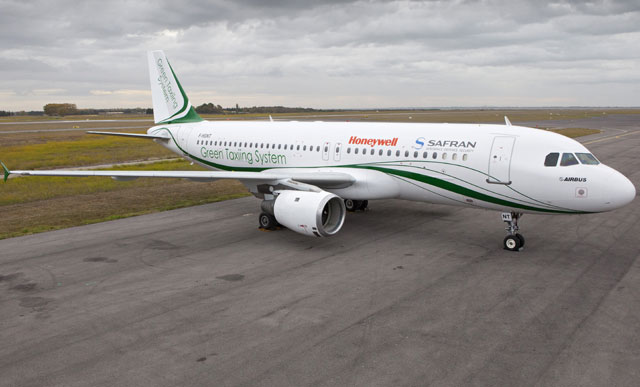Safran and Honeywell will demonstrate for the first time their jointly developed electric taxiing system on an Airbus A320 test aircraft as part of this year's flying display at Paris Air Show.
The two manufacturers have tested a prototype of the electrically-powered main wheel drive system in Toulouse, after it was installed on the narrowbody earlier in 2013. The team has taxied around 185km (115 miles) during several trial runs at the airport in south France, says Marc Ventre, executive vice-president for Safran's aerospace propulsion branch.
The prototype is in flyable condition, but has thus far not been approved for test flights. The equipment was therefore removed for the transfer to Le Bourget about two weeks ago, and has meanwhile been re-installed.
Safran and Honeywell plan to demonstrate electric taxi operations every afternoon until 21 June.
The manufacturers opted for a design with a single electric motor on each main landing gear. Both drive units are supplied with electricity from the auxiliary power unit (APU), while the two main engines can remain shut for taxi operations.
Avoiding unnecessary fuel burn and noise are the main objectives for the electric green taxiing system (EGTS). But the equipment should also cut engine maintenance costs - as the powerplants clock up less operating hours - and the risk of damage from foreign object debris on the ground.
Entry into service is planned for 2016, with the system being available both for line- and retrofit.
The initial installation and trial operations have gone well and showed need only for minor changes to the current design, says Ventre. The system's weight is "close" to the 100kg (220lb) target per drive unit.
 |
|---|
Safran/Honeywell green taxi system |
"The test pilots love it", says Ventre. They taxied the aircraft up to around 15kt (28km/h) - the target is 20kt - and performed tight turns, whereby the mains wheels on one side of the aircraft turned forward while those on the other side reversed.
Since the two companies formed a joint venture to develop the taxiing technology at the last Paris air show in 2011, the system has logged more than 3,000 lab hours of sub-system testing and garnered the interest of more than 50 airlines, says Jim Fusaro, vice-president marketing and product management for the EGTS programme.
Since an A320 test aircraft was first moved with the EGTS in mid-2012, the system has undergone more than 160km of rolling testing over a 300h period, says Fusaro. Honeywell and Safran have more than 200 engineers at a dozen sites around the world working on the system, the architecture of which was frozen in the first quarter of 2012.
Honeywell and Safran estimate that the EGTS can save up to 4% block fuel costs on an Airbus A320-sized aircraft travelling 500nm.
For EGTS, they decided to power the main wheels rather than the nose wheels, which is another approach being used in the market. Using the main wheels was a strategic decision, says Olivier Savin, Safran's EGTS programme vice-president, in a white paper released by Safran and Honeywell.
"The primary driver for powering the main wheels rather than the nose wheel is traction," he says. "Less than 10% of the aircraft weight is on the aircraft nose gear, making it difficult to achieve the taxi performance required by airlines in all operating conditions," he says.
Check out the latest news and views from this year's Paris air show, including:
- Latest news and blog headlines
- Images from the aerial displays
- Video highlights from the show
- Latest #PAS13 chat on our Twitter page
Finally, our new-look iFDN editions will contain exclusive footage from Paris 2013. Find out more
Source: Flight Daily News
















